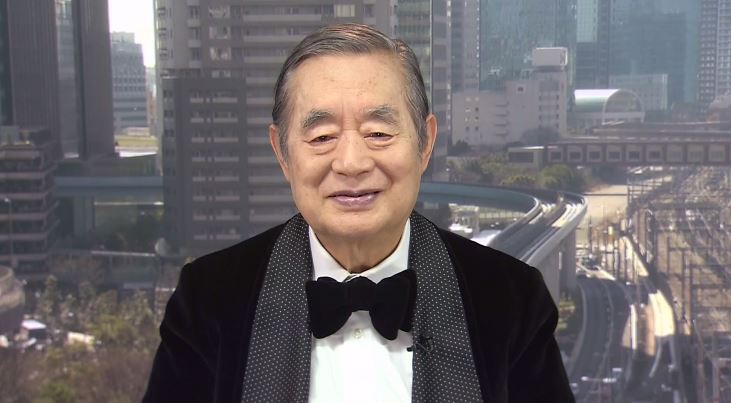BIOGRAPHY
Yoshiro Nakamatsu is a Japanese inventor. He regularly appears on Japanese talk shows demonstrating his inventions.
Nakamatsu creativity process:
In interviews, Nakamatsu has described his “creativity process”, which includes listening to music and concludes with diving underwater, where he says he comes up with his best ideas. He then records them while underwater.
Nakamatsu claims to benefit from lack of oxygen to the brain during his dives, making inventions “0.05 seconds before death.” He also claims that his “Calm Room,” a bathroom constructed without nails and tiled in 24-karat gold, encourages creative thinking by blocking television and radio waves.
Nakamatsu also has an elevator in his house that he claims helps him think better, although he strictly denies that it is an elevator and describes it as a “vertical moving room”. Nakamatsu predicts that he will live until the age of 144.
INVENTIONS
Nakamatsu is a prolific inventor, and he even claims to hold the world record for number of over 3,200 “inventions”. While his claim to a “world record” has been described as a record for patents by several media articles, several other sources do not list Nakamatsu among the world’s most prolific inventors (he has 6 patent families). Nakamatsu was the subject of the 2009 documentary The Invention of Dr NakaMats.
Among Nakamatsu’s early inventions is the Shoyu Churu Churu, a siphon pump used in the home to move soy sauce from large containers to smaller vessels for cooking and serving. His patented inventions include:
- Juusyoku Record (or “Jūshoku Record”) (重色レコード, stacked color record / dual color record) – An optical sound media which uses printed paper sheet instead of transparent film (1952)
- “Magnetic record sheet” – “a method for forming signal record track comprising a number of spiral signal track loops …” (1964)
- “Enerex” – System for generating hydrogen and oxygen
- “PyonPyon” – Jumping shoes with leaf springs on their soles
- “Cerebrex” armchair, a chair that supposedly improves mental function such as calculation and thinking by cooling the head and heating the feet
- A toilet seat lifter
- A condom with an embedded magnet, supposedly “improving sensitivity” as “electricity is generated in the blood vessels in the female organs by Fleming’s left-hand rule”
- A protective envelope for floppy disk (1975-1983), and a head-cleaning floppy disk (1981-1988)
- A CD for supposedly “enhancing brightness or sexual function”
- A cigarette-like device for supposedly “activating the brain”
- A pillow preventing falling asleep while driving (an air compressor strapped to the cars headrest, forcibly feeding air to the driver)
- A peephole in a sheet of material, described as a “oneway visible shielding object”
- Spectacles in the shape of eyes, so that the user appears to wear no spectacles
- A “wig for self defense” — a strip and a weight are attached to a wig. The wearer swings the wig to hit an attacker.
- Love Jet – A sexual enhancement product which he created out of concern about Japan’s declining birthrate. In a 1995 interview, he explained that the purpose of the aphrodisiac was “to save Japan”.
PERSONAL LIFE
Nakamatsu is the son of Hajime Nakamatsu, a banker, and Yoshino Nakamatsu, a teacher who provided early tutoring in mathematics and science and encouraged him to begin inventing. He studied engineering at the University of Tokyo. He has three children.
In June 2014, Nakamatsu, who has contended that it should be possible for people to reach 144 years of age by taking care of their health, revealed that he is suffering from prostate cancer and that his doctors did not expect him to live past the end of 2015.
He has sought a new treatment for the disease. In September 2015, Nakamatsu appeared at the awards ceremony for the Ig Nobel prizes, where he performed a song about his medical condition.
MEDIA COVERAGE & RECOGNITION
Nakamatsu has appeared on several American TV shows, including Lifestyles of the Rich and Famous, Late Night with David Letterman, CNN’s Make, Create, Innovate, and Bizarre Foods with Andrew Zimmern. He also appeared on the BBC show Adam and Joe Go Tokyo and the BBC radio show Jon Ronson On… In 2005, Nakamatsu was awarded the Ig Nobel Prize (a parody of the Nobel Prize) for Nutrition, for photographing every meal he has consumed during a period of 34 years.
In 2009, Danish filmmaker Kaspar Astrup Schröder made a humorous documentary about Nakamatsu titled The Invention of Dr. NakaMats. In 2010, Nakamatsu claimed he had been granted an honorary title by the Sovereign Military Order of Malta. Since then, he has introduced himself as Sir Dr. NakaMats, although his claim has been denied by a representative of the order.
In 2013, Nakamatsu was featured on the Sky 1 programme, The Moaning of Life, where Karl Pilkington travels the world to see how people face up to life’s biggest issues. In 2015, Full Metal Breakfast released a song called “Dr. NakaMats.” in 2016, Nakamatsu was awarded the first Museum Lifetime Visionary Award “in recognition of a uniquely decorated life dedicated to the pursuit of that which we do not yet know” during a celebration of his 88th birthday.
The ceremony, held in Cortlandt Alley in New York City, was planned in conjunction with the museum’s exhibition of various inventions and personal artifacts of Nakamatsu.
In 2019, Nakamatsu was featured in a short mini-documentary by popular YouTube channel, Great Big Story. In the documentary, Nakamatsu discusses some of his successful inventions and shows his process that he uses to come up with his inventions. As of December 12, 2020, the video has over 4.2 million views.
The contents of this page are sourced from Wikipedia article on 26 September 2022. The contents are available under the CC BY-SA 4.0 license.
Table of Contents
Toggle
